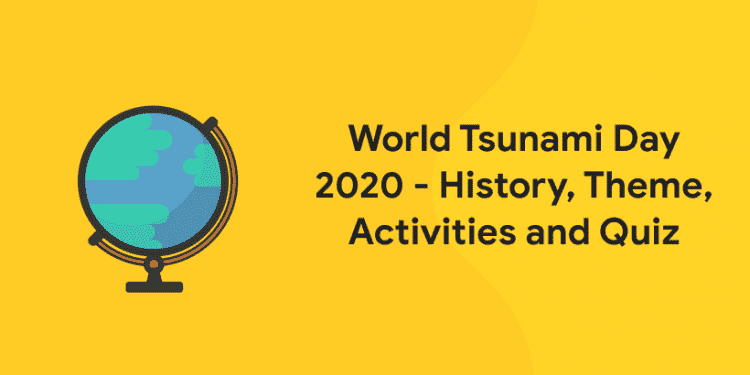Table of Contents
International days are marked to educate the public on issues of concern, to address global problems and to celebrate and reinforce achievements of humanity. Each international day provides the community an opportunity to organize activities related to the theme and to create public awareness on the same. Organizations, governments, public and private sectors, schools, universities and citizens make international day a springboard for awareness raising actions. In this article let us check on World Tsunami Day 2020 – History, Activities and Quiz
Attempt daily quiz by subscribing to Entri
World Tsunami Day 2020 – Thursday, 5 November
In this article readers can get a glimpse on
- What is Tsunami and what are its causes
- History of World Tsunami Day 2020
- Theme of World Tsunami Day 2020
- Ten Worst hit Tsunami in History
- Activities that can be observed on World Tsunami Day 2020
- World Tsunami Day 2020 Quiz
About Tsunami and its Cause
1: Who was the first woman President of India?
The word “tsunami” comprises the Japanese words “tsu” (meaning harbour) and “nami” (meaning wave). A tsunami is a series of enormous waves created by an underwater disturbance usually associated with earthquakes occurring below or near the ocean. Volcanic eruptions, submarine landslides, and coastal rock falls can also generate a tsunami, as can a large asteroid impacting the ocean. They originate from a vertical movement of the sea floor with the consequent displacement of water mass.
Tsunami waves often look like walls of water and can attack the shoreline and be dangerous for hours, with waves coming every 5 to 60 minutes. The first wave may not be the largest, and often it is the 2nd, 3rd, 4th or even later waves that are the biggest.
What are the causes of tsunamis?
Earthquakes
All earthquakes do not cause tsunamis. There are four conditions necessary for an earthquake to cause a tsunami:
- The earthquake must occur beneath the ocean or cause material to slide into the ocean.
- The earthquake must be strong, at least magnitude6.5 on the Richter Scale
- The earthquake must rupture the Earth’s surface and it must occur at shallow depth – less than 70km below the surface of the Earth.
- The earthquake must cause vertical movement of the sea floor (up to several metres).
Landslides
A landslide which occurs along the coast can force large amounts of water into the sea, disturbing the water and generate a tsunami. Underwater landslides can also result in tsunamis when the material loosened by the landslide moves violently, pushing the water in front of it.
Volcanic eruptions
Although relatively infrequent, violent volcanic eruptions also represent impulsive disturbances, which can displace a great volume of water and generate extremely destructive tsunami waves in the immediate source area. One of the largest and most destructive tsunamis ever recorded was generated in August 26, 1883 after the explosion and collapse of the volcano of Krakatoa (Krakatau), in Indonesia.
Extraterrestrial collisions
Tsunamis caused by extraterrestrial collision (i.e. asteroids, meteors) are an extremely rare occurrence. Although no meteor/asteroid-induced tsunamis have been recorded in recent history, scientists realize that if these celestial bodies should strike the ocean, a large volume of water would undoubtedly be displaced to cause a tsunami.
Free UPSKILLING Courses!
Take your first step toward mastering in-demand skills, acing interviews, and securing top-tier jobs with Entri's free upskilling courses.
Start Learning!History of World Tsunami Day 2020
In December 2015, the UN General Assembly designated 5 November as World Tsunami Awareness Day, calling on countries, international bodies and civil society to raise tsunami awareness and share innovative approaches to risk reduction. Tsunamis are among the most devastating natural disasters. Coastal communities often concentrated in low-lying and highly populated areas are the most potentially vulnerable to coastal hazards like tsunamis, with heavy human and economic losses. International cooperation is key for deeper political and public understanding as well as involvement in reducing our risks from these coastal natural hazards.
The Intergovernmental Oceanographic Commission (IOC) of UNESCO works to coordinate national and regional tsunami early warning services, raising global awareness about effective actions, policies and practices to reduce exposure to disaster risk through its four Tsunami Warning and Mitigation Systems for the Pacific, Indian Ocean, Caribbean, and North-Eastern Atlantic, Mediterranean and Connected Sea regions. The IOC also assists Member States through education programmes and regular tsunami communication and evacuation exercises, increasing the coordination, readiness for and understanding of tsunamis among citizens and communities around the world.
World Tsunami Day Theme 2020
- In 2020, World Tsunami Awareness Day encourages the development of national and community-level, local disaster risk reduction strategies to save more lives against disasters. This year’s observance promotes “Sendai Seven Campaign,”
- The theme of the world tsunami awareness day 2020 was “Sendai Seven Campaign”. This theme focused on reducing disaster damage to critical infrastructure and the disruption of basic services.
- World Tsunami Awareness Day 2018 theme was “Reducing Human and Economic Impacts from Tsunamis”
- World Tsunami Awareness Day 2017 theme was ‘Reduce the Number of Affected People’.
- World Tsunami Awareness Day 2016 theme was “The debut World Tsunami Awareness Day focuses on education and evacuation drills”. Tsunamis will also be a major theme of the annual International Day for Disaster Reduction on 13 October, centred on the first of the Sendai Framework’s seven targets: reducing mortality.
- In December 2015, the UN General Assembly designated 5 November as World Tsunami Awareness Day, calling on countries, international bodies and civil society to raise tsunami awareness and share innovative approaches to risk reduction.
10 Worst Hit Tsunami in History
Following are few worst hit tsunami in History.
1. Sumatra, Indonesia – 26 December 2004
2. North Pacific Coast, Japan – 11 March 2011
3. Lisbon, Portugal – 1 November 1755
4. Krakatau, Indonesia – 27 August 1883
5. Enshunada Sea, Japan – 20 September 1498
6. Nankaido, Japan – 28 October 1707
7. Sanriku, Japan – 15 June 1896
8. Northern Chile – 13 August 1868
9. Ryuku Islands, Japan – 24 April 1771
10. Ise Bay, Japan – 18 January 1586
Here is a list of the most destructive tsunamis ever recorded in modern times:
- Sunda Strait, Indonesia 2018: Java and Sumatra, Indonesia
- Palu, Sulawesi, Indonesia 2018: Palu bay, Indonesia
- Sendai, Japan 2011: Japan and other countries
- Maule, Chile 2010: Chile and other countries
- Sumatra, Indonesia 2004: Indonesia, Thailand, Sri Lanka, Maldives and other countries
- Valdivia, Chile 1960: Chile, Hawaii, Japan, Philippines and other countries
- Lisbon, Portugal 1755: Portugal, Spain, Marocco, North Africa and other countries
Free UPSKILLING Courses!
Take your first step toward mastering in-demand skills, acing interviews, and securing top-tier jobs with Entri's free upskilling courses.
Start Learning!World Tsunami Day 2020 Activities
The activities that can be conducted as a part of observation of world tsunami day are mentioned below
- Conduct awareness session in the society
- Educate people on tsunami and its effect
- Conduct quiz and surveys to check their knowledge on the same
- plan and execute evacuation drills at community, schools and institutions to help the people be aware on what has to be done thus helping in risk reduction
- Disaster management session has to be conducted at institutions and community
- Support organisations that help people during disaster
- Join as volunteers in disaster management sector of your society
- Help in fund raising to help the victims of Tsunami
World Tsunami Day Quiz 2020
1. What does the word tsunami mean?
2. What is usually the cause of a tsunami?
3. What type of plate margin was involved with the Indian Ocean tsunami of 2004?
4. What is the main cause of tsunamis?
5. What is the wavelength of a tsunami?
6. What is the main factor determining the speed and size of a tsunami once it has been generated?
7. What is the biggest tsunami on record?
8. The 2004 Indian Ocean tsunami resulted in a tragic loss of how many lives?
9. What is the longest period of time waves from a tsunami can affect a coastal area?
A) 0.1 m
B) 0.2 m
C) 1 m
D) 0.5 m
E) 0. 3 m
floor is called a
A) Ocean storm
B) Wind-generated disturbance
C) Wave train
D) Wavelets
E) None of the above
occur?
A) Wavelength increases, wave period decreases, and wave height stays the same
B) Wavelength decreases, wave period decreases, and wave height increases
C) Wavelength decreases, wave period increases, and wave height increases
D) Wavelength decreases, waver period stays the same, and wave height increases
be in such open ocean conditions?
A) 300 km/hour
B) 400 km/hour
C) 667 km/hour
D) 500 km/hour
E) 600 km/hour
called
A) Sea level drop
B) Draw fall
C) Drawdown
D) Dip in sea level
E) None of the above
A) It will subside
B) It will remain unchanged
C) It will momentarily rise
converging plates, what will happen?
A) The seafloor will suddenly subside
B) The seafloor will suddenly be driven upward
C) The seafloor will slide passively in a lateral direction parallel to the strike of the
interface
D) Nothing will happen
a. 1999
b. 2004
c. 2010
d. 2007
a. Hardly noticeable waves
b. Small cresting waves
c. Huge cresting waves
d. Huge non‐cresting waves
a. Apia
b. Upolu
c. Savaii
d. Stewart Island
a. Divergent margins
b. Convergent margins
c. Transform margins
How Entri will help you with the preparation for Competitive Examinations
- Entri Provides you an online platform to prepare for the exam
- You can download the app free of cost and join the class
- Entri provides video classes as well on various important topics by the excellent faculties
- Entri provides revision modules, monthly tests based on the classes
- Entri provides an excellent platform with full- length mock tests including previous year question papers
- It also gives you access to clarify your doubts
Attempt the following Quiz by Entri to boost your score in the examination
Few important international days and its significance by Entri.












